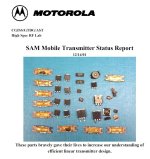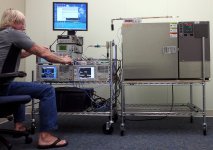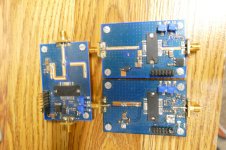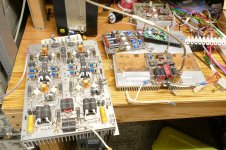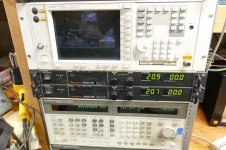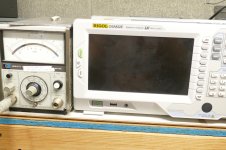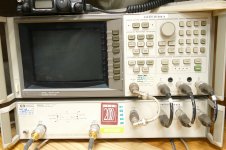You did well there, especially as at that time you could buy exactly what they wanted off the shelf!These guys described a reasonably small tracking device that could be hidden in a fairly large object which remained inert until remotely activated, then provided real time location of the object until remotely deactivated. The unit must operate wirelessly over a cellular network and operate for a day in tracking mode or remain in standby mode for a week or more. Prototype cost was no object, but information on possible production cost was needed. I had asked several times for a good description on the object to be tracked, but kept getting vague answers. One of the guys told me to assume that it was the size and weight of a baby grand piano.
We found out about the vehicular tracking from a security guard at the college. It seems that one of his PI buddies was doing the tracking. No further details ever surfaced despite what could have been a messy and expensive divorce, the kind that makes the news. Boca Raton is a rather pricey part of South Florida. Manalapan is an exclusive community within Boca where entrance to the area is by permission only. What happens there, stays there.Funny... well, was she cheating on him?
My BS degree was in Computer Engineering at what was a third tier college at the time. I would have gone for EE but their EE program had just lost accreditation. Most of the CE stuff I already knew since I had been building "computers" since the mid 70's. Most of the coursework involved Borland Turbo Pascal and Turbo C.Not to mention they knew little of Computer Engineering... After all, it's a field that I entered before the field existed as a recognized independent branch of software development.
After getting an "Engineering Degree" at Motorola's request and expense, I transferred out of the phone development group into a research group where they wanted an "advanced" engineering degree. OK, let me get this right, you want to pay me to leave work, drive up to Boca and hang out at a college for a couple hours, and sleep (or play Doom on my 80286 laptop) through a class? OK, sign me up. What was my "specialty" in choosing classes toward a MSEE degree? "Easy classes that were offered at 8:00 AM or 5:00 PM" was my answer. I had already collected enough of them to take the MS degree and run. Or I could hang out for a few more years and chase the PHD, which would involve some "unique research" project. That research was the subject of the conversation when the "suits" walked in. A few months later the decision was made for me. Motorola decided to pull all funding for MBA and PHD degrees since a large percentage of those two groups leave the company within two years of graduation. It would have taken about $20K to pay for my PHD, which was not coming from MY pocket. Back then, the EE Times magazine pegged the maximum EE salary at a MSEE degree since "PHD's rarely do any REAL engineering."
Most people here know my take at "real engineering." We have all seen vacuum tubes glowing a bit too much. The picture shows the cover page for a report I did on some advanced high powered data transceiver technology. Yes, I'm known for melting a few vacuum tubes, but in reality, I have fried far more silicon, GaN, GaAs, and SiC than vacuum tubes....and got paid to do it!
Attachments
You got lucky that was only some big Whig trying to get out of a divorce settlement. What they warn you NOW is NEVER to engage with someone who hands you a proposal like that because he is more likely than not an agent of a foreign power. And to discreetly report the incident to your FSO.
I ran into Computer Engineering as a thing over at Broadcom and WDC... I mean, you know you gotta do something besides writing firmware when the "hardware" in the emulator doesn't seem to work. Huh? I mean, I was going to work to find errata! So, RTL it was... So it was Computer Engineering time... read me some books, talk to the guys on the other side of the hall... learnt a lot, worked 24/7... These guys were chip designers...
( Someday, I'll tell you about Cymer... that was all of that, and Physics ).
Smoking stuff? Bravo... well, we don't really do that much anymore. But, have you ever smoked a $250K Not For Flight Board? That was in '85 mind you! The lab was noisy with fans so I guess I ignored the blowing caps.... but I could not ignore the white jet of plasma coming out of the 1/4 watt diode... THAT got my attention... That job was analog electronics ( well we had digital interfaces, but no RF) so yeah, the voltages could get rather high. I got used to handle 100w, 0.1 ohm resistors we used for measuring current.
Smoking that Board was the highlight of my analog electronics career.. I mean, you just can't top that and still not get fired. Can you?
OH, the MS thing... well, I decided to go consulting. They didn't care about an MS... and I knew a couple of guys who had actual PhDs (one in Physics, one in Math)... but they hid it as in consulting they look for "engineers" not "scientists". Over at the Lab I once led an integration project and herding the PhDs into getting work out of them was my hardest task. Anyhow, once my income tripled I had no desire to go back to school. Working long hours, making pretty good money, I spent my free time sleeping or drinking Manhattans.
@wg_ski Your comment about the FSO applies when you are working in the guts of the MIC. If you're in commercial, and if the work doesn't come under an Arms Export (ITAR) restriction, you're free to do as you wish. Except your employer, if you're a full time employee, not a contractor, might want to know what you do with your free time. I've work concurrent jobs many times in my career, supporting different programs, with start up, small and large companies, and so long as you observe the NDAs everything is OK. Also, try not to work concurrently for competitors... that is not a good thing to do...
( Someday, I'll tell you about Cymer... that was all of that, and Physics ).
Smoking stuff? Bravo... well, we don't really do that much anymore. But, have you ever smoked a $250K Not For Flight Board? That was in '85 mind you! The lab was noisy with fans so I guess I ignored the blowing caps.... but I could not ignore the white jet of plasma coming out of the 1/4 watt diode... THAT got my attention... That job was analog electronics ( well we had digital interfaces, but no RF) so yeah, the voltages could get rather high. I got used to handle 100w, 0.1 ohm resistors we used for measuring current.
Smoking that Board was the highlight of my analog electronics career.. I mean, you just can't top that and still not get fired. Can you?
OH, the MS thing... well, I decided to go consulting. They didn't care about an MS... and I knew a couple of guys who had actual PhDs (one in Physics, one in Math)... but they hid it as in consulting they look for "engineers" not "scientists". Over at the Lab I once led an integration project and herding the PhDs into getting work out of them was my hardest task. Anyhow, once my income tripled I had no desire to go back to school. Working long hours, making pretty good money, I spent my free time sleeping or drinking Manhattans.
@wg_ski Your comment about the FSO applies when you are working in the guts of the MIC. If you're in commercial, and if the work doesn't come under an Arms Export (ITAR) restriction, you're free to do as you wish. Except your employer, if you're a full time employee, not a contractor, might want to know what you do with your free time. I've work concurrent jobs many times in my career, supporting different programs, with start up, small and large companies, and so long as you observe the NDAs everything is OK. Also, try not to work concurrently for competitors... that is not a good thing to do...
Last edited:
You did well there, especially as at that time you could buy exactly what they wanted off the shelf!
I think he noted the components were off the shelf, but the device itself had to be designed and put together.
The Nokia cell phone and the u-blox GPS board were indeed off the shelf items but sending "data" other than a simple SMS text wasn't a thing yet, and the phone had no I/O other than a headset jack. The board we designed used a PIC microcontroller and a 300 baud modem chip. The "data transfer" was done via audio from the 300 baud modem chip. The voice quality of the phone was the limiting factor in transfer speed, but 300 baud was plenty fast for a short string of characters from the GPS board.You did well there, especially as at that time you could buy exactly what they wanted off the shelf!
We thought that it was rather weird at first when they wanted us to design something but wouldn't tell us what it was. Once we found out who the players were, it was obviously not a James Bond kind of thing. The lawyer worked for the family of a president of the USA.What they warn you NOW is NEVER to engage with someone who hands you a proposal like that because he is more likely than not an agent of a foreign power.
I walked into the Motorola plant about 30 miles from where I grew up in response to a full page "Technicians Wanted" ad in the Miami Herald newspaper. I got hired to build, test and tune HT-220 police walkie talkies as they came off of the assembly line. After about a year and a half of that crap I got a job in the cal lab keeping that factory running and improving its throughput, AKA a Mr. Fixit! That was the most fun time of my entire working life. Along with all of the other Mr. Fixits in the compartmentalized "micro factories" in the plant, we set new standards in creative goofing off when the factory was running smoothly. Did we create an "explosion" that rocked the whole plant, yet left no evidence that it ever happened? Maybe, maybe not......do not put about 1 liter of liquid nitrogen in a 1 gallon soft plastic bottle, screw on the cap and walk away. LN2 jet powered paper airplanes, and jet car races across an unused part of the factory floor. Who, Me? Someone launched a UFO out of the courtyard every new years eve for 7 or 8 years in a row. The sightings made the Miami TV news twice. I wouldn't know anything about that. One year we thought the fun was over. The son of the plant manager came to work on the night shift for a summer internship. The biggest boss in the whole plant's son would be working with us to learn the inner workings of the plant and get college credit for it........It was a most excellent summer, as he was essentially untouchable by any boss in the building. Get caught drag racing the facility management golf carts? No problem, daddy will make sure that we can do it again if we want to.Smoking that Board was the highlight of my analog electronics career.. I mean, you just can't top that and still not get fired. Can you?
Somehow I was blamed for setting the cal lab on fire which triggered the fire suppression sprinklers and flooded the place. I was out in the radio factory fixing a problem with a bunch of onlookers playing supervisor, so I wasn't present when the fire happened. I was the "person in charge" of the lab on night shift, so I got to eat the blame. We spent several days of 14 hour shifts cleaning up the mess and sorting out the soggy test equipment, and nobody ever asked how the paint spray booth caught on fire. After ten years of fun at the beach in the morning and fun at work until midnight, I saw the factory slowly migrating to the other side of the world and got a "real job" in engineering. They put me in charge of the "audio section" of a new radio. This was 1985, my home stereo stuff used transistors then. So did my DIY guitar amps.
Fortunately for me, intentionally blowing stuff up was part of my job description. I did take it to extreme sometimes. What management doesn't know won't hurt them. We designed technology that would be used in "mission critical" radio equipment. This meant that someone's life often depended on that radio working. You can't "test" that kind of quality and reliability into a product, you must "design" it in. Every part in those units was fully characterized and used well within its limits. It was often my job to find those limits.
Most of the SMD mosfets in the "fried parts" picture were because someone in the product design group who didn't fully understand what he was doing decided to use a "bigger and better" mosfet than the part I specified in a 12 to 28 volt boost converter that ran at almost 2 MHz. Using a 20 amp mosfet with 4000 pF of gate capacitance makes for rounded gate drive and the parts would get hot enough to unsolder themselves. He reported up the food chain that my boost converter design sucked. One he brought me one of his burnt boards, it took me about 10 minutes with a heat gun to swap out the fets and make his burnt board work. Near the end of my career our group had morphed into an IC design group. That stuff did not interest me, so I took the buyout and left after 41 years.
Fun times..
Ever used a "shaker table"?
Essentially they are big speakers with an "oven/refrigerator" box on top. Used for testing and validating electronics through heat/cold/shaking cycles.
I was programming them for manufacturing and metrology. So, we got this new one.. .a BIG one... and we were running out of rooms on the main floor (two floor building, offices above, manufacturing and labs below ). So this new one, we installed it on the ground floor, pretty close to the middle of the building, just off our lab. The others were way out of the way in a single story corner by receiving inspection.
So, we hooked it up and I got the bright idea of hooking up my Sony Walkman as a signal source. Played "Sympathy For The Devil", low pass filtered to about 300 Hz and let her rip.
Well, we found vibration modes throughout the building we didn't know about. Best yet... our location turned out to be pretty still, but the 2nd floor shook like crazy.. people thought we were having The Big One and all the engineers, suits, high heeled ladies, etc... etc... all came running down the stairs and out the building.
We heard the commotion, locked the door, turned off the thing, made some coffee and didn't come out for hours. Laughing our heads off, or course.
Those were good times. Working with wires, boxes, lights, cables, benches, meters, scopes, generators, labs.... I love working in labs. I find them like a 2nd home. Always wore the white smocks... I got yelled at once by the QA inspector because I grabbed a blue one and went onto the factory floor... I noticed that in the last 15 years the rules have been relaxed, but then, OMG, it was like...
Ever used a "shaker table"?
Essentially they are big speakers with an "oven/refrigerator" box on top. Used for testing and validating electronics through heat/cold/shaking cycles.
I was programming them for manufacturing and metrology. So, we got this new one.. .a BIG one... and we were running out of rooms on the main floor (two floor building, offices above, manufacturing and labs below ). So this new one, we installed it on the ground floor, pretty close to the middle of the building, just off our lab. The others were way out of the way in a single story corner by receiving inspection.
So, we hooked it up and I got the bright idea of hooking up my Sony Walkman as a signal source. Played "Sympathy For The Devil", low pass filtered to about 300 Hz and let her rip.
Well, we found vibration modes throughout the building we didn't know about. Best yet... our location turned out to be pretty still, but the 2nd floor shook like crazy.. people thought we were having The Big One and all the engineers, suits, high heeled ladies, etc... etc... all came running down the stairs and out the building.
We heard the commotion, locked the door, turned off the thing, made some coffee and didn't come out for hours. Laughing our heads off, or course.
Those were good times. Working with wires, boxes, lights, cables, benches, meters, scopes, generators, labs.... I love working in labs. I find them like a 2nd home. Always wore the white smocks... I got yelled at once by the QA inspector because I grabbed a blue one and went onto the factory floor... I noticed that in the last 15 years the rules have been relaxed, but then, OMG, it was like...
Last edited:
We had two of them for a short time. The original used a bunch of 6550 tubes and some BIG transformers. Its replacement was solid state. It came with several canned profiles and a "displacement" knob. Nothing on the planet could survive "Military Jeep" with the displacement turned up full. We shook stuff apart just to watch it fail. Shortly after the old system was scrapped, a high speed camera was installed in the new system that could be synchronized to the table profile with a variable "phase" knob. This opened up a new set of eyes into "modes of destruction."Ever used a "shaker table"?
The shaker table was fun, but the guy who wrote this book built us a sound proof room that could simulate any real world environment from an acoustical standpoint. He had ventured into fun places like a vehicle assembly line in a Chrysler plant, a steel mill, a lumber processing plant, the flight line at a nearby Air Force Base, and other loud places. Lets just say that someone we all know decided to recreate a Pink Floyd DSOTM concert....a few times. It seems that the sound proof room wasn't completely sound proof.
https://www.amazon.com/Determining-...r_1_11?crid=73REA9V83ZVA&dib=eyJ2IjoiMSJ9.eio
The college that I attended was less than a mile from the big IBM plant where the PC was born. If you went into a fast food place at lunch time the IBM engineers were easy to spot. Dress pants, fancy shoes and shirt and always, a necktie. There was no dress code, formal or implied at Motorola. When I worked second shift as a Mr. Fixit I wore shorts, a T-shirt or tank top depending on weather, and a pair of flip flops. I kept a pair of slip on moccasins under my desk for the few times I had to go into an area where the supervisor enforced the "closed toed shoes required on the factory floor" rule. The clean room for quartz crystal fab was a white lab coat only place, and it was enforced. The microelectronics clean room was also a lab coat area, but it was not enforced for service people like me. Once I got into engineering the shorts became jeans and I rarely wore tank tops because the engineering buildings had far better AC and no hot smelly wave solder machines, reflow furnaces, or other major heat sources.I love working in labs. I find them like a 2nd home. Always wore the white smocks..
As the company went into a downsizing spiral after the breakup by the Wall Street Wizards there were plenty of empty offices, conference buildings, and other chunks of empty space. I often worked on multiple non compatible tasks simultaneously so I had an oversized cubicle in the lab area, but when I need to do something that could interfere with my usual mostly automated IC testing, I just took over some empty space. Much of the work being done in the main lab was with highly sensitive narrow band FM radio receivers which were (and still are) commonly used by public safety officials (police, fire, and EMT walkie talkies). The setup seen in the photo was used to perform load pull testing on a 770 MHz transmitter that put out a 5 or 10 MHz wide LTE signal with 120 watts of peak RF power. This would trash any nearby receiver measurements, so I took over a 10 X 20 foot meeting room for my private lab several hundred feet away from the main lab. I was asked to remove my "DANGER 120,000 Milliwatts" sign on the door since it scared people.
Attachments
That picture... flat screen, ~20 inch, 4:3... 2009? You're still using HP stuff. That's function generator ( or a power meter? ).... Big chassis PC, no laptop in sight. RF coax cables, Pizza in the oven... analog testing, huh? Frequency and power. Sidebands. A little bit of analog waveform analysis ( rise and fall times... ).... I stopped doing that back in the 90s when I went full firmware development... even chips now are RTL ( VHDL ).
In SoCal the hardware guys wore ties and long sleeve shirts... we joked they were clip-on ( they were!!)... and them pocket protectors. Remember those? We software guys wore short sleeve sport shirts. Always shoes, of course. No High Heels for the ladies in the labs.
I used to joke "No Heels, No Coffee, No Hope in the labs"
The IBM guys were known for being truly... I don't know, we laughed at them, they were so darn stuffy. Even here in the West Coast where our dress code was mellower than anything else you saw in the country ( East Coast, yikes... ).
There was always a distinction, as well, between the Baby Killing Machine (MIC) and Commercial. Dealing with the stiff DOD and anything GOV was always more formal than with some MBA. It still is.
Only during the late 90s did we start to wear jeans... but shorts were (still are) a no no, even for the ladies. Tank tops? Nope. Heck, in the 00s I had to travel to the East Coast. Ohio and Texas for meetings and I always wore jeans and a polo shirt. Even the stiffs over there always dressed up like they were going to church or something like that.
But in the 80s, jeans were a no no and you definitely always, even today, have to wear shoes. Although back in the 90s, working on commerical, we used to wear beach pants to work.. but tennis shoes... slippers were a no no.
Once, when HR over the East Coast noticed how casual we dressed over here, this was '94, they floated a "dress code" but it got shot down by our managers. We heard about it...
So, the next month, when we had the monthly big whig manager meeting, I wore a tuxedo to work. ;-)
Oh.. clean rooms... steel toes, goggles, mask, gloves and bunny suits. Always. A PITA when you gotta use the bathroom.
In SoCal the hardware guys wore ties and long sleeve shirts... we joked they were clip-on ( they were!!)... and them pocket protectors. Remember those? We software guys wore short sleeve sport shirts. Always shoes, of course. No High Heels for the ladies in the labs.
I used to joke "No Heels, No Coffee, No Hope in the labs"
The IBM guys were known for being truly... I don't know, we laughed at them, they were so darn stuffy. Even here in the West Coast where our dress code was mellower than anything else you saw in the country ( East Coast, yikes... ).
There was always a distinction, as well, between the Baby Killing Machine (MIC) and Commercial. Dealing with the stiff DOD and anything GOV was always more formal than with some MBA. It still is.
Only during the late 90s did we start to wear jeans... but shorts were (still are) a no no, even for the ladies. Tank tops? Nope. Heck, in the 00s I had to travel to the East Coast. Ohio and Texas for meetings and I always wore jeans and a polo shirt. Even the stiffs over there always dressed up like they were going to church or something like that.
But in the 80s, jeans were a no no and you definitely always, even today, have to wear shoes. Although back in the 90s, working on commerical, we used to wear beach pants to work.. but tennis shoes... slippers were a no no.
Once, when HR over the East Coast noticed how casual we dressed over here, this was '94, they floated a "dress code" but it got shot down by our managers. We heard about it...
So, the next month, when we had the monthly big whig manager meeting, I wore a tuxedo to work. ;-)
Oh.. clean rooms... steel toes, goggles, mask, gloves and bunny suits. Always. A PITA when you gotta use the bathroom.
Last edited:
Yep, 20 inch flat screen 4:3 Dell monitor came with the big Dell Industrial PC tower PC lying on its side on the bottom shelf. I think the PC was made in 2005 or 2006 It had two Intel Pentium CPU's, but I don't remember exactly which ones. It ran XP. All of the test equipment AND the temp chamber were controllable via the IEE-488 / HPIB / GPIB bus. At the time I got the system the only way to get non HP computers onto the IEE-488 bus was a card that plugged into the ISA I/O buss on the PC's motherboard. I wrote my own test routines in Borland Turbo C, which required an Intel machine. The old Dell was from the exploding caps on the motherboard era, and mine had several split caps in it, but it never missed a beat and was faster than any of the test equipment that it controlled, so I kept using it until I left the company in 2014. Back at my desk in the lab there was another identical Dell setup. It controlled a whole rack of test equipment for IC testing.
There is an LTE transmitter in the oven and it will see a full suite of tests thrown at it starting at -40C and run at 10 degree increments to +90C. The box under the monitor is a DC multimeter measuring the current drain via a sense resistor in the B+ to the output transistors. Below that is an RF power meter. My finger is pushing a button on an RF signal generator which is modulated with a specific LTE test signal. The fancy spectrum analyzer on the left has the specific Emission Mask specified by ETSI for LTE transmission below 1 GHz on the screen in blue. The white line is the output VS frequency of the RF power amp. It must be in the blue area to pass. The spectrum analyzer on the right is for looking at the entire 100 KHz to 26 GHz spectrum to see harmonics and other unwanted spurious emission as the transmitter is put through a specified series of torture tests. The metal rod sitting atop a power supply on top of the chamber is an RF "trombone line." This is essentially a variable length piece of 50 ohm coaxial cable. The black object is a dummy load resistor with a calibrated mismatch built in. Any transmitter must meet strict criteria as to harmonic and other unwanted RF emission as it is put through a battery of tests in several temperature environments.
There is an LTE transmitter in the oven and it will see a full suite of tests thrown at it starting at -40C and run at 10 degree increments to +90C. The box under the monitor is a DC multimeter measuring the current drain via a sense resistor in the B+ to the output transistors. Below that is an RF power meter. My finger is pushing a button on an RF signal generator which is modulated with a specific LTE test signal. The fancy spectrum analyzer on the left has the specific Emission Mask specified by ETSI for LTE transmission below 1 GHz on the screen in blue. The white line is the output VS frequency of the RF power amp. It must be in the blue area to pass. The spectrum analyzer on the right is for looking at the entire 100 KHz to 26 GHz spectrum to see harmonics and other unwanted spurious emission as the transmitter is put through a specified series of torture tests. The metal rod sitting atop a power supply on top of the chamber is an RF "trombone line." This is essentially a variable length piece of 50 ohm coaxial cable. The black object is a dummy load resistor with a calibrated mismatch built in. Any transmitter must meet strict criteria as to harmonic and other unwanted RF emission as it is put through a battery of tests in several temperature environments.
Attachments
LOL...
Remember this baby? The 8568. We had it with the 2Ghz expansion.

I programmed it with one of these (HP Workstation Basic) HP9000 - 300... except ours had the wheel on the keyboard. Like the 9836.

I paid the mortgage for several years being an expert on HP-IB Automated Test Set stations. Built many of them, even created my own ATLAS like interpreters. I wrote the interpreter, the system utilities and the device drivers. Ran in WS Basic and HPUX too.
Those were the days, huh?
Oh, who can forget this one? The one that finally kicked off Tektronix off our benches... the Mighty HP1980B scope..

The first "scope" that I met that you could just punch a button ( or send a command over the HP-IB bus ) and it would seek and lock onto the signal. Then you could read the frequency, amplitude, rise and fall times, etc... it was a scope and an analog signal analyzer - up to video signals.
Remember this baby? The 8568. We had it with the 2Ghz expansion.
I programmed it with one of these (HP Workstation Basic) HP9000 - 300... except ours had the wheel on the keyboard. Like the 9836.
I paid the mortgage for several years being an expert on HP-IB Automated Test Set stations. Built many of them, even created my own ATLAS like interpreters. I wrote the interpreter, the system utilities and the device drivers. Ran in WS Basic and HPUX too.
Those were the days, huh?
Oh, who can forget this one? The one that finally kicked off Tektronix off our benches... the Mighty HP1980B scope..
The first "scope" that I met that you could just punch a button ( or send a command over the HP-IB bus ) and it would seek and lock onto the signal. Then you could read the frequency, amplitude, rise and fall times, etc... it was a scope and an analog signal analyzer - up to video signals.
I still have a Tektronix 475 scope in daily use... And a fair bit of test gear 30+ years old that does fine from Marconi, HP, and others. Most of the modern stuff (5G cell site emulator etc) is Anritsu.
Last edited:
I left Motorola over 10 years ago. I have been building my own basement workshop during that time with mostly old equipment. As with most DIY workspaces everything is in a constant state of flux. There is one workbench just for tube audio stuff, which is mostly HiFi and guitar amp related, but I have been working on some vacuum tube modular music synthesizer stuff. There is another small workspace for coding, compiling, and testing/debugging code for some mixed analog / digital music synthesizer that uses a small CPU based "maker board" for the core.I still have a Tektronix 475 scope in daily use... And a fair bit of test gear 30+ years old that does fine
Then there is the RF bench. How many home workshops have a fully functional HP8753 network analyzer, or 3 fully functional HP8664A low phase noise 3GHz RF sig gens and a 1 GHz HP8664B. The sig gens were all dead units purchased off Ebay for cheap over a two year period. There are also two parts units and a collection of parts mostly from the Dayton Hamfest. These all came to me at a total profit since my collection of working units grew beyond my needs and I sold one working HP8664 and two HP8642A's for enough to pay for all of the stuff I kept. There is an E4406A transmitter tester, an HP4353B VCO/PLL signal analyzer (does phase noise plots) and two kilowatts of power (33 volts at 33 amps, can be wired in series) for some of my experiments. Chip amps for RF? Yes, One makes about 15 watts on 902 MHz and the other two make less power on 2304. All were made about 15 years ago for my DIY cross band repeater which died young from eating a lightning bolt. These modules were spares.
Attachments
All of the test equipment AND the temp chamber were controllable via the IEE-488 / HPIB / GPIB bus. At the time I got the system the only way to get non HP computers onto the IEE-488 bus was a card that plugged into the ISA I/O buss on the PC's motherboard.
My "bread 'n butter" as well. Undebatably the best job in the place. Completely out of the "front lines" trenches; most coworkers happy to have me automating their measurements. Eventually becoming "indispensable" having my work in Acoustic, Shock and Vibe, thermal measurement, EMI, power supply, Environmental and airflow measurement setups.I paid the mortgage for several years being an expert on HP-IB Automated Test Set stations.
One summer in my career, I got to sit by myself out in the "OATS" facility writing a program to automate turntable rotation, antenna height and data collection from the RF analyzer. What peace. Compared to the pressures other engineers endured at my salary.
Another fun moment was when their package "drop" machine got kicked off the network due the OS wasnt good enough. They asked me to write a replacement software controller. No docs on the machine; I had to open the box, looking inside and figure out what did what. Analog signals depicting pressure, digital word representing the height the work table was pulled up to, a "brake" signal which locked or released the table from the rails it rode on. I did it. Program the pressure in the cylinders the "feet" landed into, pulled the table up to a height, drop the table and then catch it at the peak of the rebound in RT on a Windows machine. All from my own little head...
I bet you all have some fun programming stories to tell!
QA inspector, we don't need no QA inspector......They will never find me here.keep the QA inspector out of your lab.
Oddly they didn't seem to put much effort into verifying the cal status of much of the equipment in the engineering labs, but inspections on the factory floor happened randomly without notice or warning. Sometimes an official from a city, company, or government facility that was about to place a large order for radio equipment would show up for a factory tour. The plant was built in 1969-1970 and went operational in 1971. I got hired in 1972, and got into the cal lab in 1974. The first random unannounced OHSA inspection occurred a few years later. Guess who got blamed for the first "major safety hazard" ever handed down to that plant.....I had a "get out of jail free card though."
There was a large Perkin Elmer plasma etch / vapor deposition chamber in the thin film microelectronics factory that required both 480 volt three phase power, and 120 volt single phase. Someone had wired the 120 volt circuit into a breaker that was shared with another power hungry device. This would randomly trip the breaker shutting down both machines. Both machines required a lengthy start up procedure, so this killed production throughput. I went down to the factory maintenance room, but nobody was home, so I swiped a breaker from their stash put it in the panel and wired Elmer, AKA Captain Nemo to the new breaker. The panel had room for more breakers, but the cover plate had no more breakaways for the handle. I taped a piece of cardboard over the uncovered box and wrote "LIVE Stay The Fxxx Out" across the face. I wrote a memo explaining all of this to the electrician who was not at work that night, made a few paper copies, left the original on the electrician's desk, a copy on his (day shift) boss's desk, and a copy on my (also day shift) boss's desk. In typical fashion nobody did anything, and the man from OHSA showed up about a week later.
When hand held walkie talkies are tested at the On Air Test System they needed to be hand held. The person holding the unit needed to have certain physical characteristics. I would assume these characteristics would resemble those of a typical user, but for some reason, I was deemed the perfect "TEST DUMMY." The DUMMY would stand on the turntable hold the radio in one of two positions or clip it into the belt holder and spin....slowly, very slowly. The radio would transmit, and RF sensors would record the pattern.One summer in my career, I got to sit by myself out in the "OATS" facility writing a program
My experience with programming involved self taught DIY assembly language stuff on the SWTPC 6800, Assembler and Basic on the Apple II clone, or Basic on my seriously modified TRS-80 in the 1970's. I didn't get any real programming experience until I started college in 1989 at age 37 for a computer engineering degree. The real outcome of getting a 4 year degree in 3 years while working full time was the knowledge that programming is a good hobby, but I would never want to do that as a career path. A good programmer needs at least two qualities, a logical mind, and patience. I fall short in the patience department. I still remember enough C to make decent Arduino Sketches for Teensy boards, which isn't much.
Well, yeah. Out in the lab, I used to mumble obscenities which were louder that I was aware of, when my program didnt operate in the way I'd hoped. A buddy, working as a bench tech would hear me and say "Tell us how you really feel, Joe". Got noted doing that in the cubes also, by the group sec. I noted that the manager of the within earshot customer service group, a fellow with a Brit accent, got to do that all he pleased. But, I wasnt a manager... The mechanical group's thermal lab had a "potty mouth" cup, filled with dollar bills. None were mine.I fall short in the patience department.
Isnt it amazing the patience department has a new friend these days, ChatGPT? Supposedly can take some of the the tedium out of text programming.
I wonder if you could give it your "starting effort", commenting each line on what you think it should do. Then ask ChatGPT "Clould you make this work better, leaving the comments in place?" ChatGPT: Sure!
A few days ago I mentioned my experiences with DIY Electronic Fuel Injection in post #3365 of the following thread, and a few posts after that. The subject came up again in posts 3387, 3388, and 3389.
https://www.diyaudio.com/community/threads/post-a-picture-that-makes-you-laugh.402055/page-169
Now I get an advert from Temu trying to sell me EFI conversion parts. I clicked on the ad and there are lots of all the bits and pieces needed to convert a carbureted V-8 engine to EFI. Who is running searches through our forum posts, mining the data and probably selling it?
https://www.diyaudio.com/community/threads/post-a-picture-that-makes-you-laugh.402055/page-169
Now I get an advert from Temu trying to sell me EFI conversion parts. I clicked on the ad and there are lots of all the bits and pieces needed to convert a carbureted V-8 engine to EFI. Who is running searches through our forum posts, mining the data and probably selling it?
Attachments
Last edited:
- Home
- Member Areas
- The Lounge
- Is it Big brother, or Comcast?
